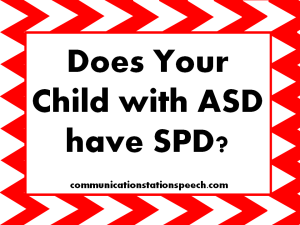Tip Tuesday: Does Your Student with ASD have Sensory Processing Disorder?
It’s April (well almost)! It’s my FAVORITE month of the year as an SLP because it is AUTISM AWARENESS MONTH!!!! And those of you who have been following me for some time now know how much I love talking about all things ASD related. So…today’s topic is on ASD and SPD. So let’s get on with it, shall we?
Do you have students diagnosed with (or suspected to have) ASD (autism spectrum disorder, for anyone new to these acronyms) on your caseload who demonstrate behaviors which appear to be idiosyncratic, seemingly lacking a purpose? Does your student have meltdowns or outbursts for no “apparent” reason? Does your student demonstrate aggressive or self-injurious behaviors “out of no where”? Or does your student seem to avoid or withdrawal from certain situations (i.e. cafeteria, recess, assembly, bus, etc.)?
If the answer is yes to any of those questions above, my next question would be, do you know and understand how that student processes sensory information? If the answer is no, you may be missing a very large piece of the diagnostic and therapeutic puzzle. I know what you are asking yourselves right now, “Maria, I’m a speech-language pathologist, not an OT. Why do I need to learn about sensory processing?” Well, did you know, that more than three-quarters of children diagnosed with ASD also have significant symptoms of sensory processing disorder (SPD)? Did you also know, that deficits in sensory processing affects all areas of development and learning?
Knowing how your student processes sensory information will (and should) change the way you present information, in which environments you present information and your understanding of the purposes behind these idiosyncratic behaviors. In fact, in my experience, once I can determine a child’s sensory processing abilities, and look at the situation through that lens, many of these behaviors and the purpose underlying their use (avoidance, withdrawal, sensory overload, etc.) becomes quite clear.
Sensory Processing Disorder, in a nutshell, is atypical, inefficient, or ineffective processing of basic sensory information. This can result in confusion, anxiety and stress which negatively affects learning and results in deficits in social communication. In general, the brain of someone with SPD has difficulty filtering the information it receives from it’s five senses to determine what is and is not important.
There can be three basic types of filtering issues: over-filtering, under-filtering, or mixed filtering issues. When a child’s brain is over-filtering, he/she is filtering out information which is necessary for learning to take place. When a child’s brain is under-filtering, he/she is not selective enough and therefore is attempting to process extraneous information unnecessary for learning. Mixed filtering means just that, a child may be under and over-filtering information depending on which sensory area you are assessing.
The type of filtering issues with which a child presents has a direct impact on the types of behaviors the child will exhibit. However, once you know and understand how filtering issues and how they result in various behaviors you can begin to understand the underlying cause of your student’s conduct.
This is an area that gets overlooked quite often when treating persons with ASD so I highly encourage all people working with this population to learn about sensory processing, SPD, the types of filtering issues one can exhibit and how that affects behavior.
My product, Sensory Needs and ASD: What EVERY SLP Should Know!, is a 24 page pdf file that provides a basic view of sensory processing needs of children with ASD and what speech-language pathologists must understand so as to meet the sensory needs of their students in order for learning to occur. This product addresses implications for speech therapy when working with children with ASD who exhibit sensory processing issues, definitions of sensory processing and sensory processing disorder, filtering issues and the effects on self-regulation and learning, hyper- and hyposensitivity related to sensory needs, how to work with students with sensory needs, available sensory processing checklists to evaluate sensory needs, and examples of classroom accommodations for children with sensory needs.
Sound like the perfect product for you to learn all the quick and dirty ins and outs of SPD? Well that’s exactly what I made it for and if you grab it this week it’s on sale so…click the link above for more details!
Sensory processing is an area of great need for children with ASD. And so many times these children cannot tell us what they are “feeling” or how their body is responding to various stimuli. So knowing how they process various input is necessary for us to fully understand them and could be the missing link to working with students on your caseload.
Enjoy!


No comments yet.